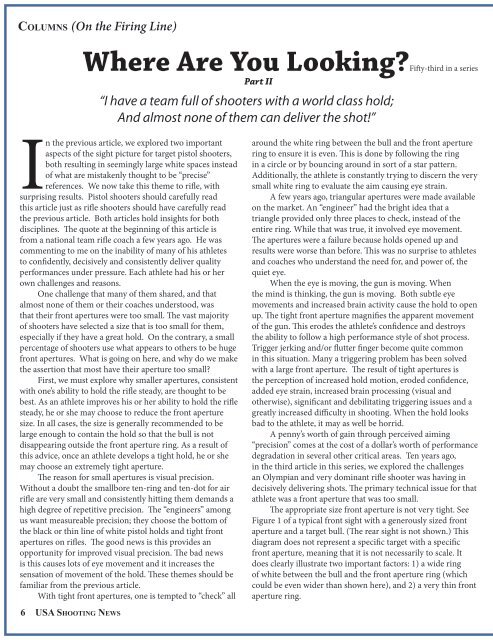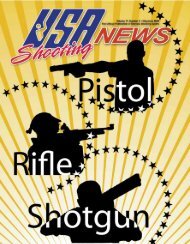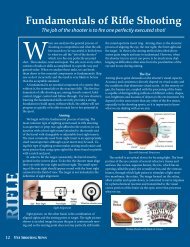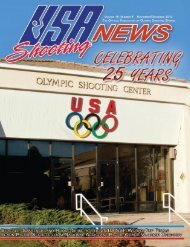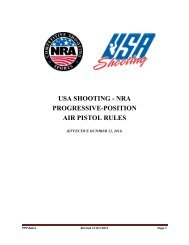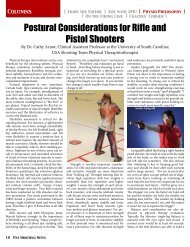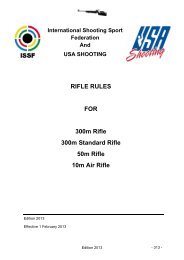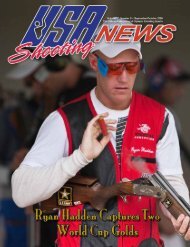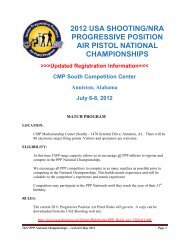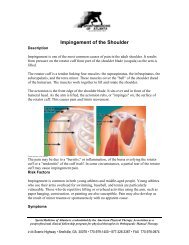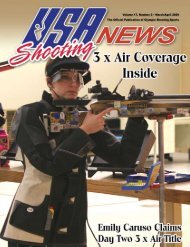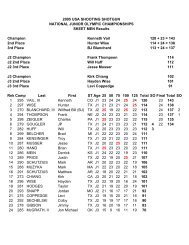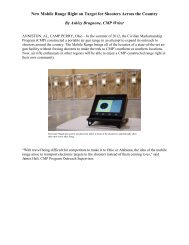January/February 2011: Volume 19, Number 1 - USA Shooting
January/February 2011: Volume 19, Number 1 - USA Shooting
January/February 2011: Volume 19, Number 1 - USA Shooting
You also want an ePaper? Increase the reach of your titles
YUMPU automatically turns print PDFs into web optimized ePapers that Google loves.
Columns (On the Firing Line)<br />
Where Are You Looking?Fifty-third in a series<br />
Part II<br />
“I have a team full of shooters with a world class hold;<br />
And almost none of them can deliver the shot!”<br />
In the previous article, we explored two important<br />
aspects of the sight picture for target pistol shooters,<br />
both resulting in seemingly large white spaces instead<br />
of what are mistakenly thought to be “precise”<br />
references. We now take this theme to rifle, with<br />
surprising results. Pistol shooters should carefully read<br />
this article just as rifle shooters should have carefully read<br />
the previous article. Both articles hold insights for both<br />
disciplines. The quote at the beginning of this article is<br />
from a national team rifle coach a few years ago. He was<br />
commenting to me on the inability of many of his athletes<br />
to confidently, decisively and consistently deliver quality<br />
performances under pressure. Each athlete had his or her<br />
own challenges and reasons.<br />
One challenge that many of them shared, and that<br />
almost none of them or their coaches understood, was<br />
that their front apertures were too small. The vast majority<br />
of shooters have selected a size that is too small for them,<br />
especially if they have a great hold. On the contrary, a small<br />
percentage of shooters use what appears to others to be huge<br />
front apertures. What is going on here, and why do we make<br />
the assertion that most have their aperture too small?<br />
First, we must explore why smaller apertures, consistent<br />
with one’s ability to hold the rifle steady, are thought to be<br />
best. As an athlete improves his or her ability to hold the rifle<br />
steady, he or she may choose to reduce the front aperture<br />
size. In all cases, the size is generally recommended to be<br />
large enough to contain the hold so that the bull is not<br />
disappearing outside the front aperture ring. As a result of<br />
this advice, once an athlete develops a tight hold, he or she<br />
may choose an extremely tight aperture.<br />
The reason for small apertures is visual precision.<br />
Without a doubt the smallbore ten-ring and ten-dot for air<br />
rifle are very small and consistently hitting them demands a<br />
high degree of repetitive precision. The “engineers” among<br />
us want measureable precision; they choose the bottom of<br />
the black or thin line of white pistol holds and tight front<br />
apertures on rifles. The good news is this provides an<br />
opportunity for improved visual precision. The bad news<br />
is this causes lots of eye movement and it increases the<br />
sensation of movement of the hold. These themes should be<br />
familiar from the previous article.<br />
With tight front apertures, one is tempted to “check” all<br />
around the white ring between the bull and the front aperture<br />
ring to ensure it is even. This is done by following the ring<br />
in a circle or by bouncing around in sort of a star pattern.<br />
Additionally, the athlete is constantly trying to discern the very<br />
small white ring to evaluate the aim causing eye strain.<br />
A few years ago, triangular apertures were made available<br />
on the market. An “engineer” had the bright idea that a<br />
triangle provided only three places to check, instead of the<br />
entire ring. While that was true, it involved eye movement.<br />
The apertures were a failure because holds opened up and<br />
results were worse than before. This was no surprise to athletes<br />
and coaches who understand the need for, and power of, the<br />
quiet eye.<br />
When the eye is moving, the gun is moving. When<br />
the mind is thinking, the gun is moving. Both subtle eye<br />
movements and increased brain activity cause the hold to open<br />
up. The tight front aperture magnifies the apparent movement<br />
of the gun. This erodes the athlete’s confidence and destroys<br />
the ability to follow a high performance style of shot process.<br />
Trigger jerking and/or flutter finger become quite common<br />
in this situation. Many a triggering problem has been solved<br />
with a large front aperture. The result of tight apertures is<br />
the perception of increased hold motion, eroded confidence,<br />
added eye strain, increased brain processing (visual and<br />
otherwise), significant and debilitating triggering issues and a<br />
greatly increased difficulty in shooting. When the hold looks<br />
bad to the athlete, it may as well be horrid.<br />
A penny’s worth of gain through perceived aiming<br />
“precision” comes at the cost of a dollar’s worth of performance<br />
degradation in several other critical areas. Ten years ago,<br />
in the third article in this series, we explored the challenges<br />
an Olympian and very dominant rifle shooter was having in<br />
decisively delivering shots. The primary technical issue for that<br />
athlete was a front aperture that was too small.<br />
The appropriate size front aperture is not very tight. See<br />
Figure 1 of a typical front sight with a generously sized front<br />
aperture and a target bull. (The rear sight is not shown.) This<br />
diagram does not represent a specific target with a specific<br />
front aperture, meaning that it is not necessarily to scale. It<br />
does clearly illustrate two important factors: 1) a wide ring<br />
of white between the bull and the front aperture ring (which<br />
could be even wider than shown here), and 2) a very thin front<br />
aperture ring.<br />
6 <strong>USA</strong> <strong>Shooting</strong> News<br />
jan feb <strong>2011</strong>.indd 6<br />
1/3/<strong>2011</strong> 10:45:56 AM


